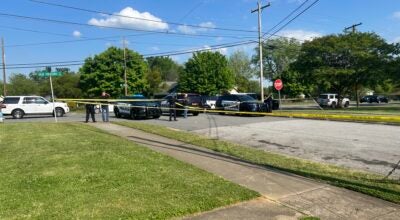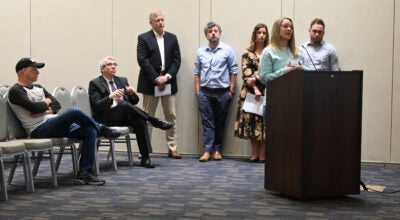Salisbury City Council hears public comments, receives presentation on Main Street reconfiguration
Published 12:00 am Wednesday, March 3, 2021
By Natalie Anderson
natalie.anderson@salisburypost.com
SALISBURY — Though a formal vote won’t be taken until March 16, Salisbury City Council members say the revised Downtown Main Street Plan appears to be a step in the right direction.
City staff presented council members on Tuesday with a revised version of a two-phased plan to re-mark, resurface and make improvements to a 10-block stretch along Main Street, between the Monroe Street intersection with South Main Street to the railroad tracks on North Main Street.
The initial draft of the Main Street Plan was presented to the City Council at a December meeting by design and engineering firm McAdams, which was hired in 2019 to create plans. Since then, staff gathered public input from nearly a dozen virtual and in-person sessions and at least 40 one-on-one discussions with downtown stakeholders.
The revised plan addresses some of the primary concerns raised by the community about parking availability, construction and pedestrian and bicyclist safety.
The first part of the plan, which involves re-marking and resurfacing by the North Carolina Department of Transportation, is expected to be complete this summer. The second phase includes a long-term vision for sidewalks and parking improvements to beautify the downtown area and make it more appealing for pedestrians. It will be funded by grants.
The project was planned in the 2019-2020 budget in the amount of $138,920. A budget to implement the city’s share of the re-marking and resurfacing plan is requested in the 2021-22 budget.
The plan includes left turn lanes throughout the entire corridor, with designated areas for bus stops and unloading zones. As one travels farther north in the corridor, parking will transition from diagonal on both sides to a split of diagonal parking on one side and parallel parking on the other.
Wendy Brindle, the city’s engineering department director, told council members that the cost of milling and resurfacing streets would be covered by NCDOT. The city, however, would be financially responsible for any other changes after the re-marking. The city will be responsible for implementing parking stripes, bicycle lane symbols and any required traffic signal changes.
When NCDOT re-marks the area, the plan proposes reducing the total number of lanes from four to three and providing a center turn lane for left turns onto Innes Street from Main Street. Additionally, the plan changes parking from the current shallow 30-degree-angle to 45 degrees, which is currently implemented next to the Bell Tower Green Park along North Church Street.
Brindle clarified that every block would have a “yellow arrow” for left turns, but protected left turns in the form of “green arrows” would be used in the Square to maximize pedestrian safety.
Brindle said NCDOT has agreed to conduct construction between the hours of 8 p.m. and 6 a.m., and will work on one lane at a time to eliminate any potential conflicts with businesses that operate at night.
The second phase, which will be dependent upon available grants, proposes sidewalk bump-outs at intersections and mid-block locations. It also includes replacing sidewalks and the addition of more street trees, trash and recycling bins, streetscape furniture, art, lighting and bike racks.
City staff say there are currently 199 parking spaces within the 10-block stretch in the plan. Following the repaving from NCDOT, 285 spaces would be made available. After the second phase, staff estimate a total of 231 or 236 parking spots. Currently, the city has 16 handicap parking spaces, and the re-marking phase would add two more. After the second phase, there would be a total of 24 spots, with approximately four located on each block.
Local resident George W. Benson thanked staff for the ability to implement more handicap parking spaces and suggested they consider spaces located at both the end and middle of each block.
Dylan Horne, who works at The Pedal Factory and is a member of the city’s Greenway Committee, has been vocal with concerns about insufficient accommodations for bicyclists. The staff presentation showed 12 bicycle parking spots currently exist. The revised plan would implement 18 spaces with the first phase and 30 with the second phase.
The revised plan includes bike lanes within the area north of the main downtown square. Between Monroe and Kerr streets, “sharrows” would be implemented, which allow bicyclists to share the road with vehicles. Horne supported the three-lane model as well and noted the mid-block crossings are key. Horne suggested ensuring they’re connected with alleyways currently utilized by pedestrians.
During public input sessions, Koco Java owner Arturo Therecka was vocal in his opposition to the three-lane model, citing concern for vehicles turning into the drive-thru during peak hours. The revised plan expanded the driveway entrance to Koco Java to 50 feet to allow for more space.
Stitchin’ Post Gifts owner Pam Coffield said during the meeting she opposed reducing traffic to three lanes due to frequent daily deliveries that would result in her employees crossing traffic to bring them inside her store, located at 104 S. Main St. The revised plan sets aside parking spots for deliveries, but also allows them to use the middle lane.
Coffield added that the plan “generates a host of problems we don’t currently have” and that the city would “be trading something we know for sure works” for something the city can’t guarantee will work.
Historic Salisbury Foundation Executive Director Sada Stewart told council members the foundation was in support of the plan.
“Salisbury has the opportunity to show the truth that preservation is progress,” she said.
Gianni Moscardini, who owns multiple downtown establishments and serves as Downtown Salisbury Inc. chair, expressed his support for the plan. Mark Lewis, vice chair of DSI, did, too.
John Ketner, a commercial real estate developer, said he opposes the plan. Ketner said many visitors, consumers and residents primarily travel by car and that being stuck behind vehicles with a three-lane model could result in hesitance to revisit the area or shop. He added the “vibrancy” the city is seeking and anticipated migration to cities like Salisbury amidst the pandemic will lead to more vehicles on the road.
Nelson told council members that, if approved, there will be a final design/construction document phase where additional modifications can be made. The second plan could potentially be implemented in phases.
All City Council members expressed support for the plan.
Council member Brian Miller said a three-lane model is something he’s been in favor of for years now. He sees such changes as necessary, citing the success of private investments being made in Kannapolis as a result of its downtown changes.
“I’m afraid if we don’t do this, we’ll look back 10 to 20 years from now and wish we did,” he said.
Miller added, however, that the city should consider ways to support businesses as construction takes place, particularly with sidewalk replacements and infrastructure implementation near their businesses.
Council member David Post said he thinks this plan is an important first step for the downtown area of the city.
“You can’t succeed if you don’t try new things,” he said.
Mayor Pro Tem Al Heggins said she wanted staff to look deeper into Coffield’s concerns about deliveries to ensure what’s best for merchants is included.
The plans can be viewed at salisburync.gov/mainstplan. City staff plan to include the presentation given to council members on the website for public viewing. Part of that includes a video demonstrating the safety improvements that result from moving to a three-lane model.
The city will continue to receive public comments for 24 hours following Tuesday’s meeting. Comments can be submitted to Nelson at anels@salisburync.gov or City Clerk Kelly Baker at kbake@salisburync.gov. Council members will revisit the revised plan and vote at the March 16 meeting.
Also at the meeting:
• By a 3-2 count, council members approved a six-month moratorium on the city’s Historic Landmark program. The issue emerged after requests in January for local historic landmark status for homes at 124 Ellis St. and 619 South Main St. Both requests were approved at the Feb. 2 meeting, but council members approved a moratorium at the Feb. 16 meeting to set goals, objectives and standards for what qualifies as a landmark property. Heggins and Sheffield opposed the measure, citing concern for appearing as if they don’t support the program.
• The council approved the rezoning of 101 acres in the 600 block of Earnhardt Road, north of Stokes Ferry Road. The rezoning request allows for the construction of homes on 246 lots as part of the fourth phase of a single-family home development. True Homes, LLC, is constructing the development, called Shay Crossing. It will eventually offer 382 single-family units ranging from 1,200 square feet to 3,600 square feet in size and from $195,000 to $285,000 in price.
• The council formally supported a grant application for money to build a sidewalk and pedestrian crossing between Brenner Avenue and a sidewalk recently terminated near Woodleaf Lanes on Jake Alexander Boulevard. The goal is to provide pedestrians with a walkway from the existing sidewalk on Statesville Boulevard all the way to the the shopping areas along Jake Alexander. It will also act as a connection to the existing/proposed greenway system by providing a starting point for a potential greenway trail to Salisbury Community Park.
The total cost of the project is $845,040, with the city responsible for a 20% match of $169,008. If the application to the NCDOT requesting funds for the project is accepted, city staff will return to council for execution of a municipal agreement.
• The council adopted an ordinance that amends chapter 16, article V of the city’s code relating to the Greenway, Bicycle and Pedestrian Committee to reflect updated titles and duties.
• Members adopted an amendment to the city’s manager’s employment agreement to clarify post-employment health, disability and life insurance benefits. Following a closed session meeting on Feb. 16, council members returned in an open session, and Mayor Karen Alexander announced that council members unanimously agreed City Manager Lane Bailey has “performed beautifully, especially in light of the challenges of the past year.” She added then that Bailey insisted on no salary increase out of concern for the current and upcoming budget.






